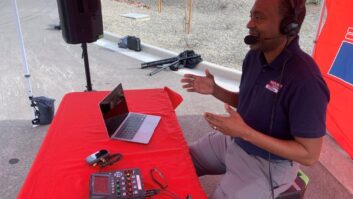Chiefs Football Surrounds the Crowd
Mar 1, 2012 2:00 AM, By Chriss Scherer, editor
The Kansas City Chiefs have been broadcast on KCFX-FM and the Chiefs Radio Network for more than two decades. Broadcasting a game on the radio may sound like a simple undertaking, but it’s far from plugging in a small mixer and two mics. Dan Israel, executive producer (and pregame show host) has been involved with the broadcasts since 1989. Near the end of the 2011 season, he took time to tell Radio magazine how a broadcast is put together.

The Chiefs have broadcast in stereo since 1990, which at the time was an unusual idea. While the announcers are essentially mono (panned center), the sound field from the stadium provides a stereo field, which immerses listeners in the experience. This experience is part of the foundation of the network’s production goals.
Production goals
There are two main production goals for every game broadcast. The first is to provide a compelling broadcast that is beyond what other broadcasters provide. This includes local and network TV coverage of the game. The second goal is to bring as much of the game-day experience to the listener as possible; this is done by painting a sonic image that includes the players, the audience, the announcers and other on-site elements. This sonic image has been provided in stereo for more than 20 years. With the 2011 season, surround sound was added. We’ll start with the stereo portion of the mix and add the surround later. For simplicity, we’ll also focus on a home game broadcast.
To create the aural image, the broadcast team gathers several audio elements. Front and center are the game announcers in the booth, Mitch Holthus and Len Dawson. There is also a sideline reporter, Kendall Gammon. Holthus and Dawson wear BeyerDynamic DT190 headsets, which have fully enclosed earpieces and hypercardioid mics. The earpieces help isolate outside sound from their monitor, and the hypercardioid mic elements drastically reduce excessive pickup of other sound sources.
While they convey the description of what is happening, the sounds of the stadium immerse the listener in sound, like he is sitting in the stadium. This ambience comes from several sources to create the surround mix.

The stereo mic on the field.
There is a stereo mic setup on the field just behind the Chiefs bench. These shotgun mics are set up with their elements spaced 90 degrees and about 12″ apart. They are panned mostly hard left and right in the stereo mix (about 9:00 and 3:00 on a pan pot). There are also two parabolic mics on the field. While it’s common to set the parabolics on either side of a team’s bench to avoid having to run around the bench, this only provides a mono signal of that end of the field of play. Instead, Israel places a parabolic on either side of the field so they follow the line of scrimmage from both sides. These mics are also panned mostly left and right (about 10:00 and 2:00 on a pan pot).
– continued on page 2
Chiefs Football Surrounds the Crowd
Mar 1, 2012 2:00 AM, By Chriss Scherer, editor
The parabolic placement and panning allows the play action on one side of the field or the other to move across the stereo field. Likewise, if the quarterback shouts a play to the right and then to the left, that verbal command is picked up appropriately.
Another source is called net effects, provided by the TV network covering the game. It includes TV crowd mics and TV parabolic mics, as well as the mic on the front of the offensive center’s shoulder pads. While the crowd noise in this feed is redundant (and often not well mixed), the offensive center mic is very useful. This mic provides the on-field feel to pick up the quarterback’s commands.

A1 Nate Wetmore (left) and Assistant Producer John Taylor sit in the upper tier of the home broadcast booth. Producer Dan Israel is in front.
The stadium provides the referee mic on the field. There is also a direct feed from the stadium PA. Both of these are panned center. The PA feed is delayed slightly for better time alignment with the PA audio that is picked up through the crowd mics.
The broadcast team has its own library of sound effects, bumpers, music beds and other effects. These are created in stereo to provide a broad stereo image. These elements will be enhanced for the surround broadcast, which will be detailed later.
Putting it together
All these audio sources are brought into the mixing system, which is a complex matrix of sources, mixes and feeds. In the past, conventional audio mixers were used to mix and distribute all the elements and various mix-minuses. While this worked, there are limitations to using a conventional mixer in this way. The game audio plan is better compared to a live stage production with a dedicated monitor mix and front-of-house mix. While the radio listener hears a complete mix of the game, various submixes are needed to feed other sources. In some cases, these submixes are not static setups; they need to be modified on the fly or with a sidechain. Sound complicated? It is, unless you have the right tool: an audio matrix system. For the 2011 season, Israel installed a BSS Blu system.

Mitch Holthus (left), play by play, and Len Dawson, analyst/color commenter, cover the game from the booth.
The BSS Blu system is a software-based audio matrix system. Audio sources are connected, and then various routing and mixing paths are created in a GUI, drag-and-drop interface. Virtual modules are placed, paths are created, effects are applied and control screens are built. While the initial set up is more complex than plugging a bunch of cables into a mixer, the end result is that nearly limitless mixes can be created, salvos preset and recalled, and the entire process saved for easy recall at the next game. For example, when a commercial break is taken, bed music starts and is faded up automatically. Then next trigger mutes the announcers from the network feed. The audio continues to be fed as an intercom. As the break ends, the commercials are faded up as a warning and a cue is given to the announcers. The announcers are unmuted and the broadcast resumes.
The on-air mix is just one feed. Multiple mixes are created.
? On-air feed to network: This is delayed about 10 seconds.
? Concourse feed: For home games at Arrowhead stadium, this feed has only the on-air talent and the return studio audio.
? Visiting team feed: Audio from the crowd noise mics
? Scoreboard feed: Just the play-by-play and color commentary for highlights replay during the game.
? Archive feed: This modified mix of game day contains color at -3dB, play-by-play at 0dB, parabolics at -6dB, crowd at -10dB. This provides a clean mix of the game without any sound effects so a clean highlight is always available.
? NFL films: A mono mix
? Visiting media: Just crowd noise. The broadcast booth windows do not open at Arrowhead Stadium, so there’s no way for visiting stations to capture crowd noise on their own.
There are multiple monitor feeds as well.
– continued on page 3
Chiefs Football Surrounds the Crowd
Mar 1, 2012 2:00 AM, By Chriss Scherer, editor
The BSS system also eliminated the need to carry external processors. The built-in DSP can be applied to add dynamics and time delay processing as needed. This effects processing is also useful in setting limits when needed. For example, if the crowd noise drastically and quickly increases, the audio engineer may not be quick enough to reduce the crowd feed manually. A smart AGC is applied to keep the crowd noise under control so the play-by-play is not covered up by the roaring crowd.
The BSS system is controlled with a Windows GUI, and various operational screens can be created as needed. The glass console idea works, but there are times when a physical interface of buttons and faders simplify things. For this, Israel’s company wrote an API to communicate with the BSS Soundweb product line via a JL Cooper MC-3000XL. This provides several soft buttons and dedicated faders to allow the audio engineer quick access to multiple elements. A fader can control an individual source or a complex submix. This simplifies operation so the engineer does not have to use an on-screen GUI. The soft buttons are programmed to execute various salvos, such as breakaways and rejoins.
Where does the surround come in? There are two more mics placed two levels up in the open window booth where TV cameras are set. This stereo shotgun pair is separate by about 12 feet. The mics are pointed higher then the field mics. This pair of mics are panned had rear left and hard rear right. The PA feed is also fed the rear speakers at a low level.

The surround mics (one of two circled) are positioned in the open booth with the TV cameras.
The on-site Enco playback system also takes advantage of the rear speakers. While the Enco DADpro is a stereo player, the effects are produced in surround and then a DTS DaySequerra Downmix encodes the file to stereo. At the game, the stereo file is played through a DTS Day Sequerra Upmix to restore it to surround.
The complete surround mix then feeds a DTS DaySequerra Downmix to encode the surround information to a stereo audio feed to the station for network distribution. If a listener does not have a surround decoder, he hears a full stereo mix.
A Musicam ISDN codec carries the stereo game mix to the studio. The two-channel return path of the codec has an on-air mix-minus for the broadcast on one channel and the intercom communication link on the other channel. A POTS line is also installed, which carries a dedicated communication link from the executive producer to the studio. The return side of the POTS line is not typically used.
At away games, the postgame feed is sent using a Comrex Access from the locker room or pressroom tied to a wireless air card or Ethernet connection. The Access can also be used for a backup audio connection if needed, as can the POTS line.
– continued on page 4
Chiefs Football Surrounds the Crowd
Mar 1, 2012 2:00 AM, By Chriss Scherer, editor
Time and travel
One major challenge in creating the broadcast is accommodating all the various delays. The Chiefs Radio Network announcers have strong ties to the team, and Chiefs fans are dedicated listeners. Some game attendees listen to the radio at the game. Home viewers will often watch the game on TV but listen to the radio audio. With HD Radio, DTV and uplinks, delay times can vary. The effect used by TV to show the line of scrimmage and the 1st down marker adds about 3 seconds. A compromise in the overall delay time is made to appease both the in-stadium and TV viewers.

The entire equipment setup is designed for flexibility, but the same equipment is also used for away games, so size and weight is a consideration. For home games, two racks are used. For away games, a single rack is used. The BSS system detects if the second rack is attached and reroute signals automatically.
For away games, the equipment is carried by and the broadcast crew travels with the Chiefs. Once the game has finished, there is a window of about 30 minutes from the end of the game until the equipment and broadcast crew have to be on the bus heading to the airport. The challenge: The post-game show lasts an hour. The one-hour post-game show is essentially created in the first 20 minutes after the game. Lead-ins and outs are recorded and fed to the studio. Locker-room and pressroom audio is gathered and fed to the studio. These pieces with recorded game highlights are reassembled back at the studio into an hour-long post-game show.
Stadium Personnel
Steve Cook – booth assistant
Len Dawson – analyst/color commenter
Kendall Gammon – sideline reporter
Bernie Haney – statistician
Mitch Holthus – play by play
Dan Israel – pre-game host/executive producer
Josh Looney – spotter
Derek Nelson – statistician
Tom Rosberg – spotter
John Taylor – creative services director, stadium assistant producer
Nate Wetmore – stadium mixing engineer (A1)
Studio Personnel
Ken Cox – studio engineer
Dennis Eversoll – market chief engineer
Art Hains – host
Gary Kline – SVP of engineering, Cumulus
Derek Nester – production assistant
Chris Sellers – segment producer
Eric Townsend – studio director
Rob Trainor – production assistant
Typical Schedule for Noon Away Game5:30 a.m.wake up call6:30 a.m.breakfast7:15 a.m.leave hotel7:45 a.m.arrive at stadium security8:00 a.m.begin booth setup (focus on pre-game needs first)9:00 a.m.pre-game begins9:45 a.m.complete booth setup (for entire game broadcast – includes RF confirmation of coordination done prior in the week via email)11:00 a.m.complete locker room and press conference setup11:10 a.m.lunch11:40 a.m.conversion from pre-game to play by play11:45 a.m.gameday broadcast begins12:00 p.m.kickoff3:00 p.m.final whistle3:15 p.m.booth strike3:35 p.m.confirm equipment load and re-dress3:45 p.m.board bus4:00 p.m.depart stadium4:30 p.m.TSA security check5:00 p.m.board plan5:30 p.m.take off8:00 p.m.land in Kansas City
March 2012
The 2012 NAB Show preview, update on STLs, the Kansas City Chiefs broadcast in surround, and Field Reports on Liquid Compass with AdsWizz and Sony Sound Forge Pro 10….












